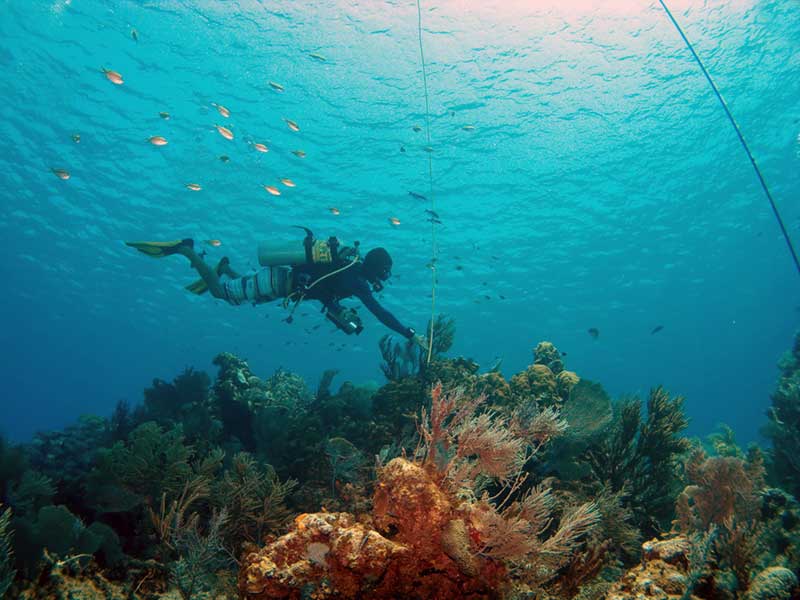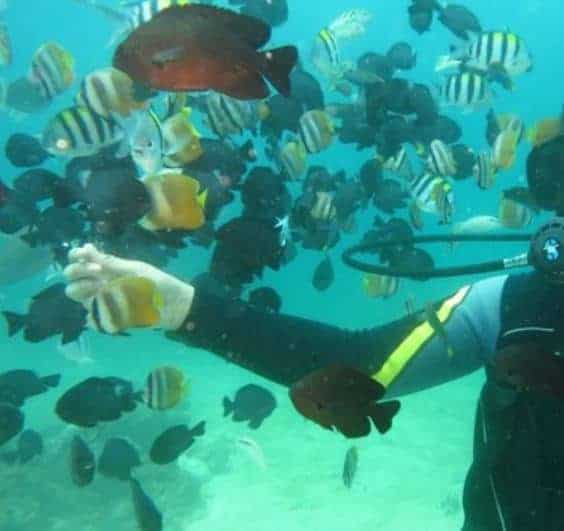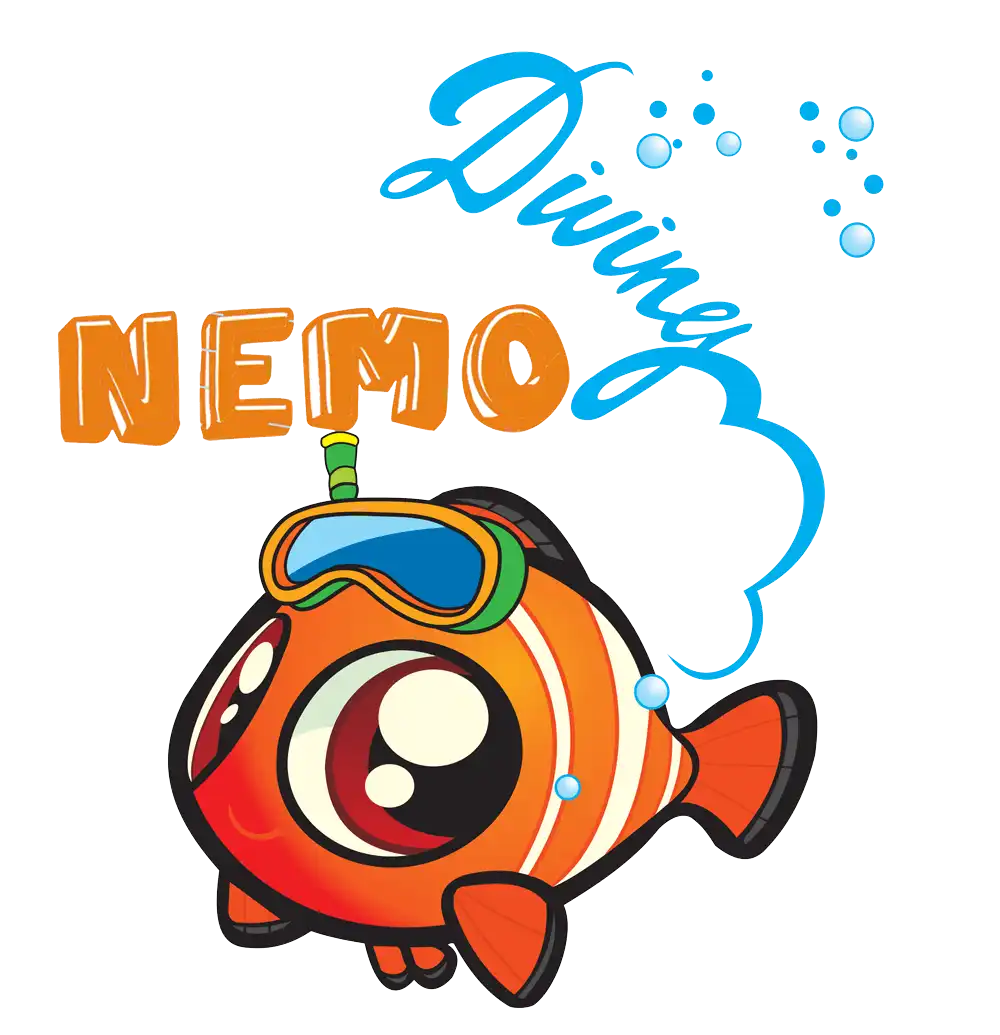
Every time you take a plunge and visit the underwater world, you are given a wonderful opportunity to explore the aquatic environment and encounter wildlife. But it’s unfortunate that some divers’ indiscriminate actions can potentially harm marine life and have an adverse effect on the environment. If you want to be an advocate for safer and healthier seas and oceans, the first step towards achieving this goal is awareness. After all, knowledge is instrumental to change and you can begin by acquainting yourself with the things that you should not do during a dive.
“Half the coral reefs are still in pretty good shape, a jeweled belt around the middle of the planet. There’s still time, but not a lot, to turn things around.” – Sylvia Earle

Coral reefs are important underwater ecosystems made up of colonies of tiny animals. Corals come in different shapes and colors and they provide shelter and protection for a wide variety of species such as fish and invertebrates.
Corals may be pretty to look at but if you feel the urge to touch them to know how they feel like … please stop! Keep in mind that these living things are delicate and a single touch can agitate their sensitive mucous membranes which shield them from diseases. When their protective membrane is affected, they can become susceptible to coral disease just like what happened in some areas of Florida, Australia, and the Mexican Caribbean. The coral structure that you see today may have taken hundreds of years to form and the onslaught of a disease can put its health in jeopardy and kill it in just a matter of weeks or months.
You can prevent this from happening by resisting the temptation to touch the corals and finding personal contentment in simply observing them.
Maintaining neutral buoyancy can be quite tricky especially for novice divers. It’s alright to make a stop to take pictures or observe wildlife during your dive but be mindful of your movements. Avoid resting or landing on corals because when you accidentally hit one and a piece breaks off, it may take many years to grow again. In fact, some types of corals are very sensitive that a small broken piece can endanger their lives. So before you set yourself down, look where you’ll be landing so you can determine if you can safely maneuver yourself or not. If you are not yet confident about your buoyancy skills, choose areas with a clear sandy bottom to avoid corals and other sensitive marine life.

Feeding fish and other marine creatures may be done in good intention but in reality, it can do more harm than good. Hand-feeding them with bread and other forms of food may promote conditioning, a behavior where creatures learn to associate food with humans. This kind of action can make them aggressive over food and put humans at risk especially when it triggers a feeding frenzy. Fish and other underwater creatures may mistake your fingers or other body parts for food and bite you by mistake. In some cases, sea creatures can display aggression and attack humans if they think that they can get food or somehow feel threatened by competitors.
Some creatures in areas where fish-feeding is rampant can become dependent on humans for food which may interfere with their natural feeding cycles and weaken their instincts for finding their own sustenance. In addition, they may not be able to get the important amino acids that they need from bread and other forms of food handed out by humans. This can also put their health at stake because certain ingredients can harm their system.
If you look at the bigger picture, the marine environment feels the repercussion of fish feeding. Many reef fishes keep the growth of algae on coral reefs under control by grazing on them. When fish becomes accustomed to humans feeding them with unnatural food like bread, it can affect their natural diet and lead to the overgrowth of algae.
The next time you go on a dive with your buddies, don’t bring any food with you. This way you can make our oceans a safer and healthier place.
The ocean is not a petting zoo where you can touch animals whenever you please. So no matter how cute or adorable an aquatic organism may seem, divers have no right to touch, chase or torment it for a photo or video opportunity. Such actions can lead to stress which may trigger the animal to produce a hormone called Cortisol. The excessive production of this hormone in the blood can be detrimental to the creature’s health.
If you’re a responsible diver, you know better than to grab a turtle by its shell so it can stay within range of your camera lens or catch a pufferfish and force it to inflate into a ball for your amusement. These are just examples of the kind of actions that are frowned upon in the scuba diving community because they show a lack of respect for marine life.
A few years ago, a video of an SSI Instructor named Mark Scott in Vietnam went viral which garnered a lot of negative feedback from netizens. It showed the instructor manhandling an octopus by pulling it out of its hiding place and stressing the poor animal.
Another video clip of a scuba diver riding the back of an endangered whale shark in Indonesia caused worldwide outrage. As seen on the video, the juvenile whale shark appeared to be in some form of distress as it struggled to swim. The perpetrator and his dive buddies were reportedly arrested for their illegal actions. Whale sharks are listed as ‘endangered’ by the International Union for Conservation of Nature (IUCN) and have been under the protection of the Indonesian law since 2013.
Don’t make the same mistake by keeping your hands to yourself. Make it your personal goal to be a good example to your fellow divers by putting the well-being of aquatic creatures at heart. If you see divers harassing marine life, do not turn a blind eye; instead, remind them of their responsibility to respect and protect underwater life.
“Take nothing but memories, leave nothing but footprints!”― Chief Si ahl
This meaningful quote is a reminder that there is no better memento of one’s dive adventure than memories. You can also take responsible photos and videos of your underwater adventure which you can share with family and friends when you go back home.
Refrain from collecting underwater keepsakes such as rocks, shells, pieces of corals, and artifacts especially in places where it is prohibited by law. If you care about the environment, the best thing that you can do is to collect obvious trash such as discarded plastic items, bottles and cans and bringing them up to the surface so you can dispose of them properly. You can also report other debris that you might find difficult to remove by yourself to local environmental authorities or institutions so they organize a trash retrieval or clean-up program. Responsible dive centers like Nemo Diving Center supports the worldwide vision of keeping our seas and oceans safe and clean by organizing dive clean-up programs in the UAE. If you are interested to participate in our underwater clean-up programs and other activities, you can visit our dive shop dubai and schedule a trip with us.
Keep these major no-nos in mind and always lead by example to inspire fellow divers to do the same. Be a responsible diver by helping raise awareness and supporting conservation efforts.
Experiences
Find the perfect escape
© 2024 NEMO DIVING CENTER
Scuba diving is an exciting and adventurous water sport that offers a chance to explore the beauty of the underwater world and its amazing marine life. The UAE, particularly Dubai, is one of the most popular destinations for scuba diving, attracting divers from all over the world. With its crystal clear waters and diverse marine life, scuba diving in Dubai offers a unique and unforgettable experience.
The cost of scuba diving in Dubai varies depending on the dive center you choose and the type of dive you opt for. On average, a single dive can cost anywhere from AED 250 to AED 550, with the average price for a single dive being around AED 350. This price usually includes all the necessary equipment, such as the dive tank, regulator, and wetsuit, as well as the services of a professional dive guide. At Nemo Diving Center, We offer a wide range of diving packages to suit every budget and experience level.
Diving in Dubai is an incredible experience, and the UAE is home to many dive sites teeming with amazing marine life including colorful soft and hard corals, sea turtles, stingrays, manta rays, moray eels, cuttlefish, octopus, nudibranchs, seahorses, and a plethora of fish species. It is also noted for its incredible dive wrecks that have become rich artificial reefs. These dive sites offer a unique and exciting diving experience, providing a chance to explore sunken ships and other structures that have become havens for marine life.
Come and explore the unique underwater world of Palm Jumeriah in Dubai and incredible dive sites in Fujairah such as Dibba Rock, Sharm Rock, Martini Rock, Snoopy Island, and more. At Nemo Diving Center, we offer dive trips to these amazing dive sites, allowing divers to discover the incredible marine life that has made the wreck its home. We also offer a wide range of other dive sites to choose from, including shallow coral reefs, deep wrecks, and drift dives, providing something for every level of diver.
In conclusion, scuba diving in Dubai offers an unforgettable experience for all levels of diver. With its clear waters, diverse marine life, and incredible dive sites, Dubai is a must-visit destination for any scuba diver. Whether you’re a beginner or an experienced diver, our team at Nemo Diving Center will ensure that you have an amazing time exploring the beauty of the underwater world.
Click one of our contacts below to chat on WhatsApp
Social Chat is free, download and try it now here!
